|
MAIN PAGE
> Back to contents
Genesis: Historical research
Reference:
Ivlev N.N.
The life and work of an artist-teacher in the Southern Urals as a manifestation of Social and Professional Heroism (based on biographical data about Victoria Mukhametovna Pitirimova)
// Genesis: Historical research.
2023. № 10.
P. 128-145.
DOI: 10.25136/2409-868X.2023.10.48484 EDN: QTKPMX URL: https://en.nbpublish.com/library_read_article.php?id=48484
The life and work of an artist-teacher in the Southern Urals as a manifestation of Social and Professional Heroism (based on biographical data about Victoria Mukhametovna Pitirimova)
Ivlev Nikita Nikolaevich
PhD in History
Associate professor, Department of Socio-Humanitarian and Psychological-Pedagogical Disciplines, South Ural State Institute of Arts Named After P. I. Tchaikovsky
454084, Russia, Chelyabinskaya oblast', g. Chelyabinsk, ul. Kaslinskaya, 27

|
Ivleven.n.n@mail.ru
|
|
 |
Other publications by this author
|
|
|
DOI: 10.25136/2409-868X.2023.10.48484
EDN: QTKPMX
Received:
06-10-2023
Published:
31-10-2023
Abstract:
The relevance of this study is due to the fact that the images of heroes reflect the values of society and realize the function of transmitting these values from generation to generation. The images contribute to the formation of ideological attitudes of society, and are a of spiritual support for both an individual and entire multiethnic nation. Outstanding artists are not only masters, but also teachers, mentors who convey not only knowledge, but also a worldview, national consciousness and ideals, the position of a citizen, educate spiritual and moral principles. The purpose of the study is the life and creative path of V. M. Pitirimova as a manifestation of the professional and social heroism of the artist-teacher in the difficult socio-economic conditions of life in Russia at the end of the XX-beginning of the XXI century. The object of research is the biography, the path of creative and professional development of Victoria Mukhametovna Pitirimova. The subject of the research is artistic and pedagogical techniques and methods used by Pitirimova Victoria Mukhametovna, her moral guidelines. The research is based on an interview with the main character of the study – V. M. Pitirimova, in which she gives an interpretation of her key creative and pedagogical achievements. In the course of the study, historical-systemic, historical-genetic, historical-biographical and diachronic methods were applied. Based on the materials obtained in the course of the study, an attempt is made to present the main milestones of the life and work of the artist and teacher Pitirimova Victoria Mukhametovna in the most complete and consistent way.The scientific novelty of the research lies in the introduction into scientific circulation of previously unexplored and unpublished information about the creative and professional achievements of Victoria Mukhametovna.
Keywords:
Pitirimova Victoria Mukhametovna, Artist-teacher, Graphic artist, Social heroism, The Khazar Dictionary Cycle, Diptych Water Line, Cycle House, Etching, Lithography, Collagraphy
This article is automatically translated.
You can find original text of the article here.
The universal characteristics of the heroic paradigm include heroization in the professional sphere. The motives of heroic behavior in this case are within the framework of the performance of official duties. Labor heroism can occur in all spheres of professional activity: in science, education, politics, art, sports, manufacturing and many others. A professional is a person who is engaged in any business as a specialist who owns a profession; a master of his craft. Professionals are traditionally opposed to amateurs, that is, those who conduct any activity by vocation, hobby or inclination. Heroism in the professional sphere is a phenomenon that has been described by many researchers of the phenomenon of heroism. Thus, V. D. Plakhov identifies a special heroic type – the hero of the master, whom he describes as "a person who has achieved outstanding results in the labor field, in the work to which he devoted his life" [1]. Heroization in the professional sphere assumes that the professional hero (hero-master) becomes the person who has achieved outstanding results in his professional activity and has received public recognition [2]. Socially heroic acts are conscious actions performed in the name of a certain value or belief. "These are noble goals, service to one's people or chosen profession, a constant, continuous search for truth, a feat in the name of freedom and life, in the name of peace and justice on Earth" [3]. Another type of heroism can be a "personal hero", which is defined as an inspiring and motivating person, not necessarily known to the general public, who is a model personality for an individual, whose ideas are conditioned by personal experience and a subjective assessment of behavior that can be considered heroic in connection with sacrifice and dedication. Parents, relatives, friends and teachers can acquire the status of a personal hero [4]. Outstanding figures of culture and art are part of the heroic paradigm of any culture, the results of their creative activity are a spiritual support for both an individual and an entire nation, preserve ethnic identity and national identity, reflect the peculiarities of historical processes and the change of cultural paradigms [5]. The pedagogical skill of a personal hero – a teacher-mentor – ensures the achievement of the main goal of pedagogical influence – the development of creative abilities of students, the education of aesthetic taste, general culture, as well as the formation of the inner world of a growing person, the disclosure of his inner individuality. 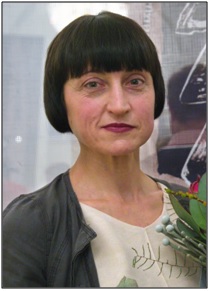 The life and creative path of Pitirimova Victoria Mukhametovna clearly shows the importance of a teacher in the life of every person, as well as the influence of a mentor on the further creative destiny of a pupil. The life and creative path of Pitirimova Victoria Mukhametovna clearly shows the importance of a teacher in the life of every person, as well as the influence of a mentor on the further creative destiny of a pupil.
In December 2022, the Chelyabinsk Museum of Art hosted the exhibition "Fathers and Children: the Fate and Creativity of Artistic Dynasties". The project examines the creativity of the artistic dynasties of Russia and the Southern Urals on a large scale. The exhibition featured paintings by Russian classics, as well as contemporary artists. Victoria Mukhametovna Pitirimova, a painter, graphic artist, chief artist of the Chelyabinsk Regional Museum from 2006 to 2012, a member of the Union of Artists of Russia, became a representative of one of the creative dynasties of Chelyabinsk who took part in the exhibition. Victoria Mukhametovna was born in Chelyabinsk on May 9, 1965. On this day, for the first time in a long time, the celebration of Victory Day was resumed. In honor of the great holiday, the parents named their daughter Victoria (translated from Latin – "Victory"). The earliest memories of Victoria Mukhametovna are connected with the city of Trekhgorny, where her family moved. The small picturesque town of Trekhgorny (a closed administrative-territorial entity) is located in the western part of the Chelyabinsk region among the three mountains Zavyalikha, Shuida and Barkhotina (hence the name of the city), in the valley of the Yuryuzan River. Victoria Mukhametovna went to school in Trekhgorny. Simultaneously with school, Victoria attended the swimming section. In Soviet times, every student in his spare time, as a rule, attended any sports sections. This organized leisure and the development of new skills in children. Schoolchildren were engaged in needlework, designing, sewing, theatrical art, etc. However, Victoria was ill so often and rarely attended classes that she had to change the direction of extracurricular activities. From the very early childhood, Victoria was able to draw well, so she didn't have to choose for a long time. On September 1, 1962, the House of Pioneers was opened in the city – a municipal institution for additional education of children for the purpose of patriotic, moral and labor education of the younger generation. During its existence, the House of Pioneers had about 50 different circles and sections, among which there was an art studio. It was there that Victoria Mukhametovna entered. The first time classes in the House of Pioneers were conducted by Anatoly Mikhailovich Dolbnya. For more than 30 years he worked as an architect of the department of capital construction of an Instrument-making plant in the city and led the creative association of artists "Rainbow". For any teacher, one of the most important qualities is the ability to interest students in their subject and instill interest in learning. According to the memoirs of Victoria Mukhametovna, classes with Anatoly Mikhailovich were very entertaining: "It was fun! We drew all sorts of funny compositions with gouache! Every time Anatoly Mikhailovich came up with something new!" Some time later, an art studio was opened in the central city library of Trekhgorny and Anatoly Mikhailovich, to the great regret of his pupils, changed his place of work. And Victoria Mukhametovna stayed to study at the Palace of Pioneers. A new teacher, Yuri Mironovich Moskvilin, started working in the art studio of the Palace.
Victoria Mukhametovna recalls: "He (Yuri Mironovich – author's note) put us to draw pots. But after the second pot, I ran away from there. I was in the third grade. We drew with a pencil, as I remember now, all the time according to the same scenario: paint over here, shade over there, erase here. Well, who needs this in the third grade?.. In general, this is how this career ended..." But in fact, Victoria Mukhametovna's artistic career did not end there. When Victoria was nine years old, the family returned to Chelyabinsk. Victoria Mukhametovna entered school No. 1. And history repeated itself – it was necessary to look for additional classes after school. Victoria Mukhametovna decided to return to drawing. Through relatives, the family learned about the art studio in the N. K. Krupskaya Palace of Pioneers and Schoolchildren. This art studio was created on the basis of an art circle at the House of Artistic Education of Children. From 1958 to 1998, the art studio was headed by Ivan Ivanovich Arkhiptsev. [URL:https://chel-dpsh.ru/] The essence of Ivan Ivanovich's approach to learning was not to retrain the child, but to preserve the individual creative handwriting of the student, along with the acquisition of new professional skills. Ivan Ivanovich became the organizer of the trips of the pupils of the art studio of the Golden Hands club in the Southern Urals, the purpose of which was to collect Ural antiquities. From the trips, the guys brought not only a large number of sketches and drawings, but also old utensils, decorative crafts, still used for still lifes. Rafting on the rivers of the Urals not only filled schoolchildren with new impressions, but also brought up fortitude, courage, the ability to bear responsibility and find solutions in difficult situations. In 1999, on the initiative of the graduates of the studio, the name of Ivan Ivanovich Arkhiptsev was given. It was Ivan Ivanovich who became a personal hero for Victoria Mukhametovna – a teacher-mentor who influenced the choice of a future profession. In the art studio of the Palace of Pioneers and Schoolchildren named after N. K. Krupskaya, Victoria Mukhametovna studied until the end of the eighth grade of secondary school. After graduating from the eighth grade, Victoria Mukhametovna decides to enroll in the Chelyabinsk Art School. He explains his choice simply: "Freedom is where art is." Parents and teachers did not react very well to the choice of profession. Mom is a communications engineer, father is an electrician. No one in the family was connected with art. Teachers did not want to let a capable student go after the eighth grade, they advised her to finish the "ten-year course", but Ivan Ivanovich stood up for Victoria's choice. He was able to convince everyone that the girl has talent and has every chance to become a successful artist and she should definitely develop in the field of art. Thanks to the intercession and support of Ivan Ivanovich, Victoria Mukhametovna successfully overcame the entrance exams and in 1980 entered the Chelyabinsk Art School. Victoria Mukhametovna recalls about her student years: "There used to be more independence, students were more mature, and there were much more guys in groups. In my group, the ratio of girls and boys was about equal. Although a couple of years earlier it was also the case that the groups were male with one or two girls. Nowadays, girls mostly enter art schools. Guys are now a rarity in creative specialties. But earlier it was due to the fact that the demand for artists was much higher. Being an artist was perceived as a normal male occupation that could really generate income. Previously, the choice of professions was not particularly wide, working specialties, medicine, and teaching. A lot of artists were needed. They were on staff, they received orders that they carried out. There were not so many printed materials. All slogans at enterprises, posters for the New Year, posters in cinemas, etc. were drawn by artists manually." Victoria Mukhametovna graduated from the college in 1984. And from the same year she began her teaching career. I got a job at the same studio where I myself recently studied. A little bit about family life  After graduation, Victoria Mukhametovna did not enter higher educational institutions. Vladimir Nikolaevich Pitirimov taught painting and composition classes at Victoria Mukhametovna's school. The teacher and the fifth-year graduate fell in love with each other, entered into an alliance, which this year turned 40 years old! In marriage, they had two children – Pavel and Anna. When the children grew up, Victoria Mukhametovna entered Magnitogorsk State University. She studied in absentia at the Faculty of Art and Design and received a specialty – teacher of fine arts and drawing. After graduation, Victoria Mukhametovna did not enter higher educational institutions. Vladimir Nikolaevich Pitirimov taught painting and composition classes at Victoria Mukhametovna's school. The teacher and the fifth-year graduate fell in love with each other, entered into an alliance, which this year turned 40 years old! In marriage, they had two children – Pavel and Anna. When the children grew up, Victoria Mukhametovna entered Magnitogorsk State University. She studied in absentia at the Faculty of Art and Design and received a specialty – teacher of fine arts and drawing.
Victoria Mukhametovna's husband, Vladimir Nikolaevich Pitirimov, is from Chelyabinsk, graduated from the V. I. Surikov Moscow State Institute in 1979. Currently, he teaches at the Chelyabinsk Art School. The daughter of Victoria and Vladimir – Anna Vladimirovna Pitirimova – like her parents, connected her life with creativity: she graduated from the St. Petersburg State Academy named after A. L. Stieglitz with a degree in Graphic Design, lives and works in St. Petersburg. The son, Pavel Vladimirovich, did not become an artist, but he is still connected with creativity – he is professionally engaged in photography. Victoria Mukhametovna, Vladimir Nikolaevich and their daughter Anna took part in the exhibition "Fathers and Children".
Victoria Mukhametovna worked at the art school for a year, taught painting. Painting classes allowed the future artists to develop the ability to see and understand the harmony of color relations, and knowledge of the basics of academic painting, methods, techniques and techniques of depicting the surrounding world with varying degrees of creative generalization allowed the teacher to skillfully approach the solution of professional artistic tasks [6]. But after working for some time with quite adult children, Victoria Mukhametovna returned to the art studio to work with younger children. Pedagogical activity Immediately after graduation, Victoria Mukhametovna started working in the art studio in the Palace of Pioneers and Schoolchildren. She continued the pedagogical traditions laid down by Ivan Ivanovich Arkhiptsev. "I have been teaching since 1984. Almost his entire adult life. I always wonder what exactly to give to children. Art is so big and voluminous. If everything is clear within the framework of the art school – realism and period, then in the format of the studio the question arises: what exactly to give to children?" Pedagogical credo of Victoria Mukhametovna: children solve serious issues of art in their works. The pedagogical principle is co–creation: communication with the pupil at the level of creative cooperation. Studio students participate in various exhibitions and drawing competitions and have high results. Their works not only decorate the Palace of Pioneers and Schoolchildren, but are also often exhibited at other venues in the city of Chelyabinsk. Victoria Mukhametovna's students can tell the best about the teacher, mentor, co-author. Arina Viktorovna Kolesnikova is a graduate of the N. K. Krupskaya Palace of Pioneers and Schoolchildren in 2019 and the Faculty of Fine Arts of the P. I. Tchaikovsky South Ural State Institute of Arts in 2023. "I wanted to go to art school, but it didn't work out... My mother found an art studio in the Palace of Pioneers. I studied there for a year, and then moved to the art studio named after him. Arkhiptseva, who was literally in the next office. It was Victoria Mukhametovna who invited me to classes. That's how my training with Victoria Mukhametovna began, which lasted more than nine years. The peculiarity of Victoria Mukhametovna's approach is the mandatory individual work with each student. She is also very loyal to her students. She approached everyone individually, looked at his strengths and weaknesses, and, importantly, was always very careful in her statements. Her words were never perceived as criticism or reproach. Rather, there was a trembling and a sincere desire to help. I never felt offended, her remarks were always on the point. Victoria Mukhametovna became not only a teacher for me, but also a psychologist, a spiritual mentor and, to a certain extent, a mother. Victoria Mukhametovna treats all her students very tenderly and with love." Elizaveta Konstantinovna Lychagina is a graduate of the art studio, preparing for admission to the Russian Academy of Arts named after I. E. Repin: "Victoria Mukhametovna Pitirimova is a unique teacher of her kind, her approach to students helps to realize both creative and educational works. One of her qualities can be called a unique approach to each of the students, depending not only on their professional skills, but also on their temperament. This helps to make the workflow interesting for children, more comfortable and productive for older children. Even at a young age, with her help, I drew full-fledged large works, some of which later participated in exhibitions of the Chelyabinsk Union of Artists. Her teaching style does not go against the views of the students. Victoria Mukhametovna gave me almost complete creative freedom, while telling me how to solve the tasks correctly. For example, throughout the time that she taught me, my main task was to enter a university, but in working on academic composition, I was always free to choose topics. Also, one of the qualities of Victoria Mukhametovna, which I have always admired, is her ability to see and feel beauty in the world around her. She always treated the form with awe and respect, whether it was the features of a human face or natural landscapes. She taught us that beauty is in the truth, in what surrounds us. She instilled a love for such beauty. One of the most vivid memories of the period of cooperation with Victoria Mukhametovna was a lesson where we looked through an album of early Renaissance artists together. This is a very subtle, simple, but at the same time brilliant art. Almost all the paintings are based on the silhouette and rhythm of the spots, preserving the iconographic naivety. Such paintings are unlikely to be interesting to a simple, unprepared viewer, as at first, they were not interesting to me. It was Victoria Mukhametovna who taught me to see this simple beauty. Another of the distinctive qualities of Victoria Mukhametovna's character can be called the constant improvement of the artist's skill. The schemes that she drew for us in the fields have always admired for their literacy and expressiveness. But at some moments Victoria Mukhametovna also studied with her students, and both with the youngest, finding expressiveness in naive children's drawings, and with older children."
Most of the graduates of Victoria Mukhametovna Pitirimova continue their studies in secondary specialized and higher educational institutions of Chelyabinsk and other cities of the country, receive education in the following specialties: artist, designer, art critic, teacher. It should be noted that in modern conditions of teaching painting, the latest computer technologies allow art students to qualitatively form a list of professional competencies, a conscious approach to design creativity, an understanding of the application of professional activity of knowledge of the basics of painting. It is worth noting the leading importance of the modern chemical industry. To date, the modern chemical industry provides artists with the latest materials for painting – interference paints, the pigment emulsion of which contains mica coated with titanium dioxide, as well as fluorescent paints that glow under the influence of ultraviolet radiation [7]. Creation Victoria Mukhametovna can be fully called a modern artist. At all times, art has talked about such topics as peace, religion, morality, expressing it all mainly in a realistic form. But with the development of art in general and the advent of photo and video cameras, the world needed new themes and new ways of expressing them. It refreshes the perception and allows you to take a fresh look at everyday things. Rethink them. "New ideas are new forms. Still, plastic expressiveness as such is very important to me. Especially when I am engaged in printed graphics. In my case, it's always a two-way process of communicating with the material. Like ping-pong: I do something with the material and immediately get a response. And it is absolutely not necessary that the response coincides with the expectation. In this "ping-pong", interaction with the process, something interesting is born, new techniques and new impressions are discovered." Victoria Pitirimova is fully free to solve a creative task in a wide variety of forms of artistic plasticity. She is equally characterized by conciseness and the ability to see the beauty of the moment, the moment. All the artist's images are free from everyday fuss and are filled with the significance of a moment of life as an eternal category. Experimenting with the theme, material, technology, Victoria Mukhametovna is able to clothe any everyday "fleetness" in an elegant form, filled with the whole spectrum of vivid artistic images. In search of the most accurate embodiment of her idea, Victoria Mukhametovna combines velvet pastels with colored ink, an expressive silhouette of a linocut with manual stencil grout, printing and application. Victoria Mukhametovna is not afraid of experiments. In order to create an expressive image, she uses various techniques, creates unusual colors and textures, combining an unusual combination of materials in her work. Embossing on etching paper, printing from a stencil with manual grout of the sheet, printing inks and colored pencils. Also in use are various paints and texture pastes, and even scraps of fabric. Etching is a technique of deep engraving on metal, in which printing is made from a metal plate under high pressure on a special machine. The image on the plate is obtained by etching it with various acids. This technique is distinguished by an extraordinary wealth of visual means, ways of obtaining images and opportunities for experimentation [8]. "The laws of art in any genre are the same – composition, color, contrast and spot. And the way the artist was able to transform them is creativity. I am interested in the form as an excuse. I mastered it all in college on a realistic and academic basis. I drew well, I had a good eye. And then it was the shape changes that became interesting. Everyone in the process of development has an interest in something new and interesting. Moreover, there is access to impressionism, post-impressionism, abstraction, and so on. I'm interested in portraying a little more than just reality. To convey the meaning of the painting through the stylization of form and composition." Today, the name of the Ural artist is well known in both Russian and international art circles. Victoria Mukhametovna is known as a modern author with her own pictorial handwriting. Victoria Mukhametovna is a laureate of many prestigious artistic forums, a member of the Professional Union of Artists of Russia. Restoration experience Victoria Mukhametovna also has experience in restoration. Alexey Petrovich Rudyagin invited Victoria Mukhametovna to the restoration of the Transfiguration Cathedral on Valaam Island. Alexey Petrovich is a graduate of the Chelyabinsk Art School, studied two years older. After graduation, Alexey Petrovich entered the Russian Academy of Painting, Sculpture and Architecture named after I. Glazunov, then worked in the Interregional Scientific and Restoration Art Department. He was a member of the restoration team, which recruited new workers. We needed proven and reliable artists. Alexey Petrovich invited Victoria Mukhametovna to work on the restoration of part of the dome, sails and walls. Valaam Island, the monastery complex, the nature of Karelia inspired Victoria Mukhametovna to create an author's printing technique. In the Water Line diptych, she combined the techniques of collagraphy with textured printing on glass, layering the resulting prints on top of each other with only one goal – to convey as convincingly as possible the depth of reflection of the immobility of the stone shore in the variability of the sea surface. Collagraphy is a relatively young print technique. It originated in the middle of the last century and is based on the principle of collage, creating a printed form by gluing various textures onto the base or applying them using all kinds of pastes. The expressive possibilities of collagraphy depend on the following components: the choice of the base (printing plate); the method of applying texture to the base; the method of scoring paint on the form (high or gravure printing method); the number of runs through the etching machine; the number of printing plates used [9]. A series of works in this technique was awarded a special jury prize at the X International Biennale of the Baltic Sea Countries in Kaliningrad in 2011.
Exhibition activities Over the years of creativity, the works of Victoria Mukhametovna have visited more than 30 different exhibitions. These are all kinds of biennales and triennales (a biennial is an event held regularly every two years, a triennial is an event held regularly every three years), international exhibitions in different cities of Russia and Europe, as well as solo exhibitions. Victoria Mukhametovna's solo exhibitions are always an unexpected exploration of the exhibition space with the help of color and light, volumes and textures, picturesque planes and graphic objects. One of the most important solo exhibitions was the exhibition "Angles of Reality", which took place in the fall of 2016. The exhibition combines graphic and pictorial cycles that are different in style, but similar in metaphorical language: "House" (1999), "Water Line" (2002), "Khazar Dictionary" (2012), "Park" (2016). The exhibition includes about 50 paintings, unique printed graphics, installation objects and glass collages. The cycle of works "Khazar Dictionary" (September 2001 – February 2002) was created based on the novel of the same name by Serbian writer Milorad Pavic. The Khazar Dictionary is a collection (there are three books in total in the cycle: red, green and yellow) of records about characters and events that are mentioned in all three parts, but are told with different details. The central theme of the cycle is the choice of religion. The author creates a new mythology, intertwining fantasy, real and fictional folk and religious traditions. The graphic sheets of the cycle "Khazar Dictionary" represent a pictorial metaphor of Pavich's texts. Victoria Mukhametovna herself sees the connection between the novel and the cycle of her works in the following: "In Pavich, events take place in the once designated unchanging living space of the Khazars, but the components inside change. In my Khazar Dictionary, the plastic components are unchanged (these are etchings repeated in different contexts), but they are placed in different spatial circumstances every time." Internship in Finland In the early 2000s, when Russian artists began to meet more often with foreign colleagues and participate in international art forums, Victoria Mukhametovna actively joined the biennial graphic movement. In 2003, she received an invitation to an international internship at the University of Applied Sciences and Arts "Saimaa", which took place in two cities of Finland: Lappeenranta and Imatra. The University was focused on the development of international projects and research activities. In its international activities, the university focused on the culture of Western Europe, the Scandinavian countries, the states of the European Union, as well as Russia, China and Malaysia. In particular, the organizers were very interested in Russia and its art school. The university is located in a border town, so student exchange and internship events were often held. There Victoria Mukhametovna took a course of classes in photopolymer engraving. Photopolymer engraving is a process in which a copper plate is covered with a special photosensitive gelatin cloth that does not need to be etched with acid. This gelatin layer is illuminated in an ultraviolet device. Then the gelatin layer is dissolved in water, and the output is a high-quality plate with deep printing. Such an engraving can reproduce smooth transitions and deep tones of the image. [10]. The university had an excellent technological base: a variety of printing equipment, lithography machines, manual and electric etching presses, in general, everything that might be needed for engraving. Workshops on printed graphics have been working at the university for many years. Artists from all over the world come to get new skills and practice. All the works created during the workshops traditionally remain in the collections of the university. In 2003, the museum of the University of Saimaa was replenished with the works of a talented Ural artist – Victoria Mukhametovna Pitirimova. Today Victoria Mukhametovna is one of the best teachers–mentors of the art studio named after her. Arkhiptseva. He works with young artists who are just starting their creative path, and with older guys who have decided on the choice of their future profession. Victoria Mukhametovna considers her task, the goal of her professional service, first of all, the ability to discern in a child a spark of creativity that exists in every artist, not to let it go out, to show the beauty of the artistic world, teach the basics of visual literacy and inspire further creativity! Victoria Mukhametovna becomes for many of her students not just the first and beloved teacher, but a personal hero, her own example and a craving for the beautiful, pushing young people on a difficult and thorny path of serving art. The most difficult pedagogical work with creative children, the lack of practice to drive everyone under a single "academic" template, the desire to discern and develop in each child his special talent, combining pedagogical service with active creative activity that does not bring significant material income – is an example of real social heroism in the field of culture and art. "Each of my pupils is a pearl," says Victoria Mukhametovna, "fragile and delicate. And my task is to convince the child that he can and should create! To see the beautiful in every moment of life! To be able to stop this moment, put ink and gouache in watercolor, pastel and show it to the world!" * The study was carried out at the expense of the grant of the Russian Science Foundation and the Chelyabinsk Region No. 23-28-10278, https://rscf.ru/project/23-28-10278 /.
** Materials of the interview with Victoria Mukhametovna Pitirimova were provided by Yanina Yana Andreevna, a graduate of the Faculty of Fine Arts of the South Ural State Tchaikovsky Institute of Arts. Applications 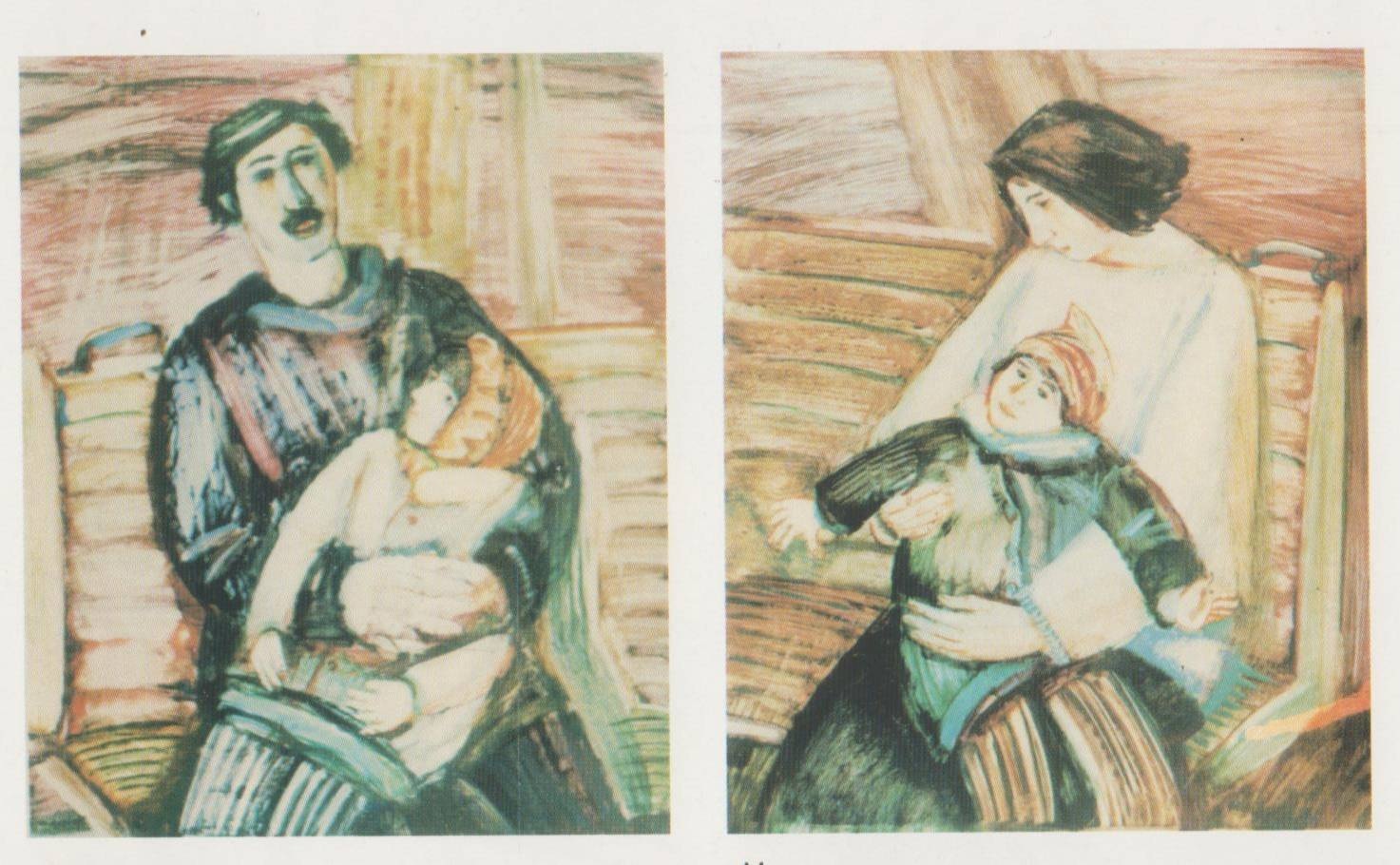
Fig.1. Left: "Father and daughter", mixed media, 1998. Right: "Mother and Son", mixed media, 1998. 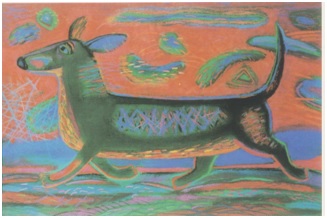
Fig.2. "Troubles" from the series "Mongrels", pastel, ink, 1998. 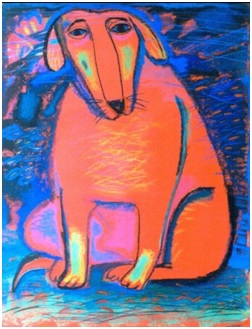
Fig.3. "Red Sadness" from the series "Mongrels", pastel, 1999. 
Fig.4. "Ceramistka", pastel, 1998. 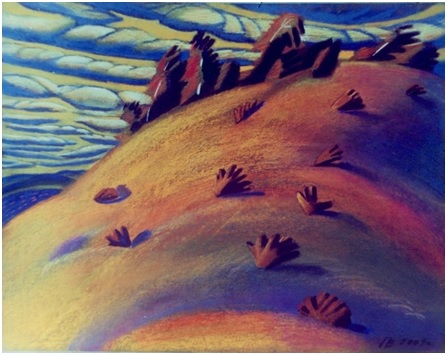
Fig.5. "Argazi Hill", pastel. 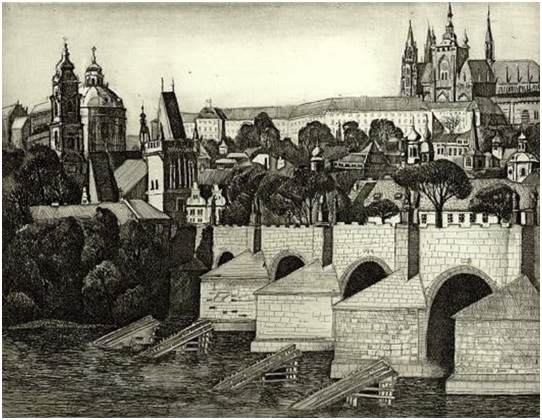
Fig.6. "Charles Bridge", etching, 1999. 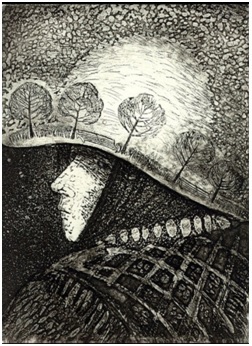 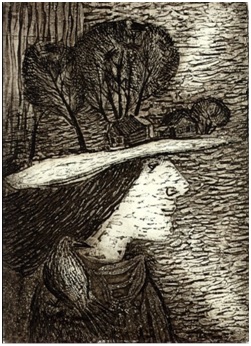
Fig.7. On the left: "Winter" and "Spring" from the series "Seasons", etching. 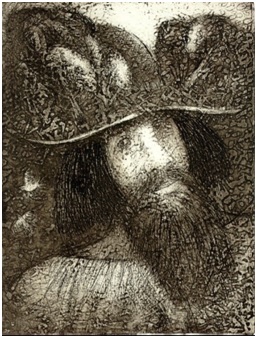 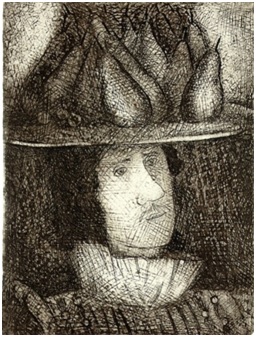
Fig.8. "Summer" and "Autumn" from the series "Seasons", etching. 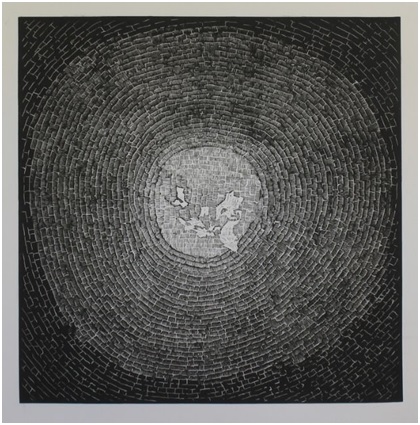
Fig.9. "Vault", linocut. 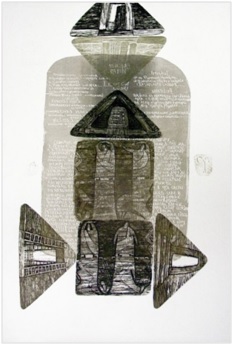 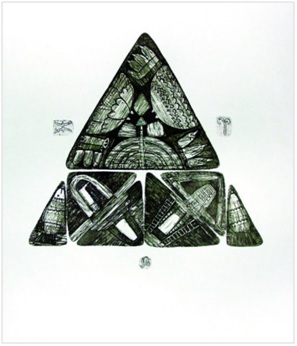
Fig.10. "Pages" from the cycle "Khazar dictionary", etching. 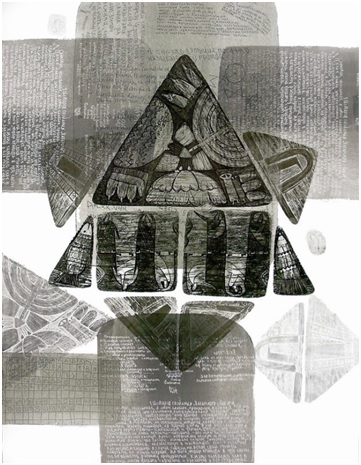
Fig.11. "The Yellow Book. Star of David" from the cycle "Khazar dictionary", etching. 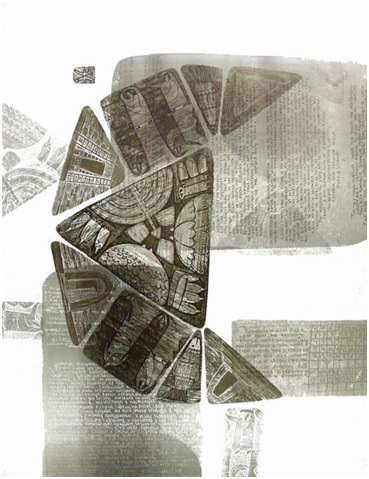
Fig.12. "Green Book. Month" from the cycle "Khazar dictionary", etching
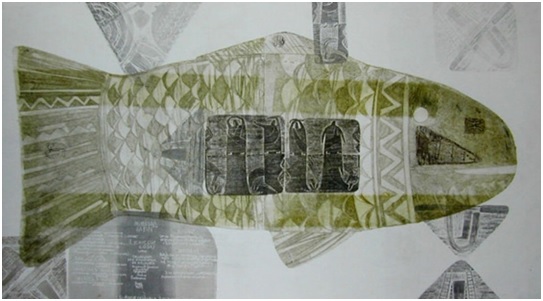
Fig.13. "Red Book. Fish from the cycle "Khazar dictionary", etching 
Fig.14. "Divorce" or "A woman with a triangle. A man with a square", etching.
References
1. Plakhov, V. D. (2008). Heroes and heroism: the experience of modern understanding of the age-old problem. St. Petersburg, Russia: KARO.
2. Tillyaev, B. A. (2014). Hero and heroism: ethical aspects of interaction. Young Scientist, 3, 1103-1105.
3. Taskaeva, A.V. (2013). "Hero of labor" in the conceptual system of the Russian person. Bulletin of the Chelyabinsk State University. Series: Philology. Art history, 37(328), 104-107.
4. Taskaeva, A.V., & Kucher N. Y. (2023). "An outstanding figure of culture and art" in the heroic paradigm of the national linguistic picture of the world. At the intersection of languages and cultures. Topical issues of humanitarian knowledge, 2(26), 114-120.
5. Taskaeva, A.V. (2020). Personal hero: features of the concretization of the heroic. Cognitive studies of language, 41, 975-979.
6. Serov, Р. E. (2009). Teaching painting to future artists of traditional applied art. Izvestiya RSPU named after A. I. Herzen, 112, 186-189.
7. Zhao, Xinxin. (2022). Methods of teaching oil painting in universities of the XXI century. Pedagogical Journal, 3A, 278-283.
8. Zotova, V. V. (2011). Artistic possibilities of etching as a book illustration on the example of Albin Brunovsky's creativity. Bulletin of MGUP, 6, 476-479.
9. Sayapina, E. I., & Ustritskaya, N. A. (2017). Technique of collagraphy in the context of modern methods of teaching prints in the bachelor's degree system of the Faculty of Art and Graphics. Online magazine "World of Science", 2. Retrieved from http://mir-nauki.com/PDF/61PDMN217
10. Martynov, V. V. (2014). Modern concepts of the influence of innovative technologies on the art of printed graphics. MNKO, 6(49), 442-444.
Peer Review
Peer reviewers' evaluations remain confidential and are not disclosed to the public. Only external reviews, authorized for publication by the article's author(s), are made public. Typically, these final reviews are conducted after the manuscript's revision. Adhering to our double-blind review policy, the reviewer's identity is kept confidential.
The list of publisher reviewers can be found here.
"Sometimes there are no names left of the heroes of bygone times" - these lines convey, on the one hand, the importance of heroes for our society, and on the other, deep sorrow for those people who unfortunately pass away from the memory of new generations. But heroes and heroism as a phenomenon carry an important educational mission, it is no coincidence that teenagers and young people look up to heroes. But it is sad not only that we do not remember the names of the heroes of past times, unfortunately we often do not notice our contemporaries either. These circumstances determine the relevance of the article submitted for review, the subject of which is the biography of the painter and graphic artist Victoria Mukhametovna Pitirimova. The author sets out to analyze Pitirimova's artistic career and teaching activities, as well as to show her family life. The work is based on the principles of analysis and synthesis, reliability, objectivity, the methodological basis of the research is the biographical method, which is based on the analysis of an individual's lifestyle and social processes occurring throughout his life. The scientific novelty of the article lies in the very formulation of the topic: the author seeks to characterize heroization in professional activity using the example of the biography of V.M. Pitirimova. Considering the bibliographic list of the article as a positive point, its versatility should be noted: in total, the list of references includes 10 different sources and studies. Among the works attracted by the author, we note the works of V.D. Plakhov, B.A. Tillyaev, A.V. Taskaeva, which focus on various aspects of studying the phenomenon of heroism and heroization. Note that the bibliography is important both from a scientific and educational point of view: after reading the text of the article, readers can turn to other materials on its topic. In general, in our opinion, the integrated use of various sources and research contributed to the solution of the tasks facing the author. The style of writing the article can be attributed to a scientific one, at the same time accessible to understanding not only to specialists, but also to a wide readership, to everyone who is interested in both the phenomenon of the hero in general and professional heroes in particular. The appeal to the opponents is presented at the level of the collected information received by the author during the work on the topic of the article. The structure of the work is characterized by a certain logic and consistency, it can be distinguished by an introduction, the main part, and conclusion. At the beginning, the author determines the relevance of the topic, shows that "the life and creative path of Victoria Mukhametovna Pitirimova clearly shows the importance of a teacher in the life of every person, as well as the influence of a mentor on the further creative fate of a pupil." The art studio visited by Pitirimova was headed by I.I. Arkhiptsev, who became "a personal hero for Victoria Mukhametovna – a teacher-mentor who influenced the choice of a future profession." The work shows Pitirimova's pedagogical credo: "children solve serious issues of art in their works." Using various examples, the author shows that "Victoria Mukhametovna becomes for many of her students not just the first and beloved teacher, but namely a personal hero, her own example and a craving for beauty that pushes young people on a difficult and thorny path of serving art." The main conclusion of the article is that "the most difficult pedagogical work with creative children, the lack of practice to drive everyone under a single "academic" template, the desire to discern and develop in each child his special talent, combining pedagogical service with active creative activity that does not bring significant material income – is an example of real social heroism in the field of culture and art". The article submitted for review is devoted to an urgent topic, is provided with 14 works by V.M. Pitirimova, and its materials can be used in understanding the phenomenon of the hero. There are some comments on the article: rather, it can be attributed to the magazine "Culture and Art" by subject, there are typos in the test. However, in general, in our opinion, the article can be recommended for publication in the journal Genesis: Historical Research.
Link to this article
You can simply select and copy link from below text field.
|
|





